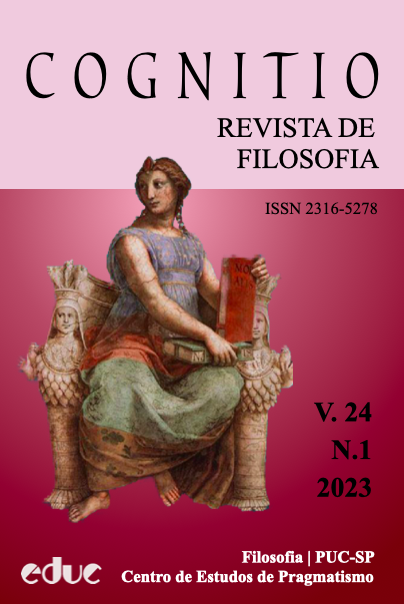A dialogicidade da estética peirciana
DOI:
https://doi.org/10.23925/2316-5278.2023v24i1:e62147Resumo
Este artigo explora a dialogicidade do objeto da Estética Peirciana. Seguindo Herbart, o pragmaticista americano, em seu relato mais maduro (1911), concebe a Estética como uma ciência que lida com os dois tipos de τὸ καλόν, a saber, com a nobreza da conduta (realizada na ação) e com a beleza sensual (experimentada na arte natureza), embora predilete sistematicamente pela primeira, isto é, pelo estudo das condições da imaginação de um fim último admirável em si mesmo (considerando assim o fim esteticamente em sua primeiridade, como uma qualidade possível) e que é pressuposto no estudo das condições de sua atualização como summum bonum (considerando assim o fim eticamente em sua segundidade, como norma que fundamenta relações diádicas de conformidade de conduta autocontrolada a ele). Como a (des)aprovação estética dos fins revela o fundamento último de imaginar a unidade de uma possível identidade prática, a Estética revela as condições de uma liberdade interior que torna a conduta autogovernada possível em primeiro lugar; não, porém, como dado transcendental, mas como resultado de práticas pedagógicas (Seção I). Em seguida, analisamos como a dialogicidade estética se origina da postura de primeira pessoa da questão fundamental que ela faz: “[O] que estou procurando?” (II.1); diferenciamos os partidos, fases e pressupostos dessa dialogicidade (II.2), e analisamos o papel de um ideal – em sua concretização metodológica como hábito de se sentir “crescido sob a influência de um curso de autocrítica e de heterocríticas” – joga pela causalidade semiótica envolvida na formação da conduta (II.3).
Referências
ALLISON, Henry. Kant’s Theory of Taste. Cambridge: Cambridge University Press, 2001.
ANDERSON, Douglas. A Political Dimension of Fixing Belief. In.: BRUNNING, J; FORSTER, P. (Eds.). The Rule of Reason: the philosophy of Charles Sanders Peirce. Toronto: University of Toronto Press, 1997. p. 223-240.
ARENDT, Hannah. The Human Condition. Chicago: The University of Chicago Press, 1957.
ARISTOTLE. Nicomachean Ethics. Trans. A. K. Thomson. London: Viking Penguin, 1976.
ARISTOTLE. The Basic Works of Aristotle. MCKEON, R. (Ed.). New York: Modern Library, 2001.
AYDIN, Ciano. On the Significance of Ideals: Charles S. Peirce and the Good Life. Transactions of the Char- les S. Peirce Society, 43 (3), p. 422-443, 2009.
BAUMGARTEN, Alexander Gottlieb. Ästhetik. Latin-German. MIRBACH, D. (ed.; trans.), Hamburg: Felix Meiner Verlag, 2007.
BAUMGARTEN, Alexander Gottlieb. Metaphysik. MEIER, G. F. (tr.), Jena, 2005.
BEISER, Frederick. The Genesis of Neo-Kantianism, 1796-1880, Oxford: Oxford University Press, 2014.
BELLUCCI, Francesco. Logic, Psychology, and Apperception: Charles S. Peirce and Johann F. Herbart. Journal of the History of Ideas, v. 76, n.1, p. 69-91, jan. 2015.
BELLUCCI, Francesco. Peirce’s Speculative Grammar: Logic as Semiotics. New York: Routledge, 2018. BRUNNING, Jacqueline; FORSTER, Paul. The Rule of Reason: the philosophy of Charles Sanders Peirce.
Toronto: University of Toronto Press, 1997.
COLAPIETRO, Vincent. The Dynamical Object and the Deliberative Subject. In.: BRUNNING, J; FOR- STER, P. (Eds.). The Rule of Reason: the philosophy of Charles Sanders Peirce. Toronto: University of To- ronto Press, 1997. p.262-288.
DE GARMO, Charles. Herbart and the Herbartians. New York: 1895; 1906.
GADAMER, Hans-Georg. Gesammelte Werke. v. 7. Griechische Philosophie III. Tübingen, 1991.
KAAG, John. Continuity and Inheritance: Kant’s “Critique of Judgment” and the Work of C. S. Peirce. Tran- sactions of the Charles S. Peirce Society, v. 41, n. 3, p. 515-540, 2005.
KENT, Beverly. Logic and the Classification of the Sciences. Kingston and Montreal: Mcgill-Queen‘s Uni- versity Press, 1987.
KIM, Alan. Johann Friedrich Herbart. In.: ZALTA, E. N. (Ed.). The Stanford Encyclopedia of Philosophy. Winter 2015. https://plato.stanford.edu/archives/win2015/entries/johann-herbart/>.
LISZKA, Jacob. Charles Peirce on Ethics, Esthetics and the Normative Sciences. New York: Routledge, 2021.
PAPE, Helmut. Erfahrung und Wirklichkeit als Zeichenprozess: Charles S. Peirce Entwurf einer Spekulativen Grammatik des Seins. Frankfurt and Main: Suhrkamp, 1989.
PAPE, Helmut. Final Causality in Peirce’s Semiotics and His Classification of the Sciences. Transactions of the Charles S. Peirce Society, v. 29, n. 4, p. 581-607, 1993.
PLATO. Werke, 6 vols. Trans. Fr. Schleiermacher. Darmstadt: Wissenschaftliche Buchgesellschaft, 1972. POTTER, Vincent. Charles S. Peirce on Norms and Ideals. New York: Fordham University Press, 1997.
TOPA, Alessandro. Charles S. Peirce on Dialogical Form. Transactions of the Charles S. Peirce Society, v. 56, n. 4, p. 475-520, 2020.
TOPA, Alessandro. “I have to confess I cannot read history so”: On the Origins and Development of Peirce’s Philosophy of History. European Journal of American Philosophy and Pragmatism, vol. VIII/2, p. 71-96, 2016.
TOPA, Alessandro. The Herbartian Roots of Peircean Esthetics and Ethics. In press.
TRENDELENBURG, Adolf. Herbarts praktische Philosophie und die Ethik der Alten. Berlin: Dümmler,
WEST, Donna. Dialogue as Habit-Taking in Peirce’s Continuum: The Call to Absolute Chance. Dialogue:
Canadian Philosophical Review, v. 54, n. 4, p. 685-702, 2015.
WEST, Donna. Indexical Scaffolds to Habit Formation. In: WEST, D; ANDERSON, M (Eds.). Consensus on
Peirce’s Concept of Habit. New York: Springer, 2016, p. 215-240.
WILSON, Aaron Bruce: Peirce’s Empiricism: Its Roots and Its Originality. Lanham; London: Lexington,
WOLF, Ursula: Aristoteles Nikomachische Ethik. Darmstadt: Wissenschaftliche Buchgesellschaft, 2007.
Downloads
Publicado
Como Citar
Edição
Seção
Licença
Copyright (c) 2023 http://creativecommons.org/licenses/by/4.0/

Este trabalho está licenciado sob uma licença Creative Commons Attribution 4.0 International License.









